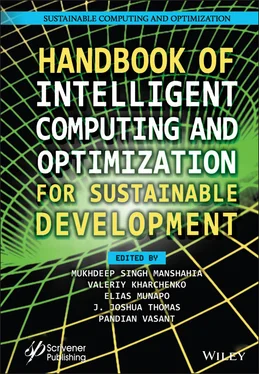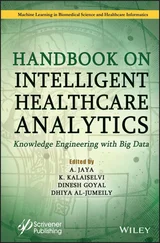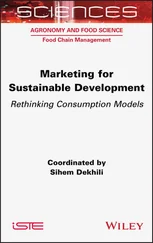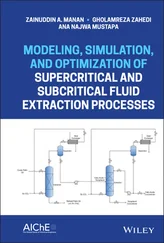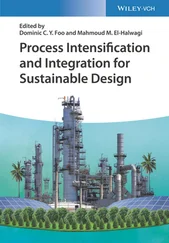In this chapter, a robust framework for the detection of garments of interest is proposed. By using a suitable background subtraction algorithm in conjunction with a person detection framework, the foreground information comprising of the garments is obtained. The application of individual color masks and morphological operations is used to obtain garment regions, which could contain multiple detected contours within the same garment. A garment linking process is utilized to link contours belonging to the same garment, thereby obtaining the active garments . The active garments that the customers find interesting, referred to as garments of interest , are obtained by utilizing a confidence score metric. This confidence score is calculated by finding the Euclidean distance between a customer’s wrist landmarks and an active garment and using the area of the active garment in the foreground of the video frames during sales interactions.
The framework was tested on a surveillance video dataset obtained from CCTV footage of an Indian garment store and was found to be effective as demonstrated by the high precision and recall values for the detection of active garments and the competence of confidence threshold in filtering garments of interest from the collection of active garments . Furthermore, the framework successfully tracked the duration for which a customer was interested in a specific garment of interest .
Additionally, we believe that a cogent extension in the future could be to utilize the posture of the head in addition to the line of sight information to improve the determination of the garments of interest for a given customer. Furthermore, visual customer demographics information can be determined from the person masks obtained to filter the garments of interest of different customer groups, enabling us to perform market segmentation. In supplement to the suggested improvements, a mapping between a given customer and the sales merchant can be established in order to determine the collection of garments of interest that are not always adjacent to the wrists of the customer in consideration.
The authors would like to express our gratitude to Aniruddha Joshi, Goutham Kanahasabai, and Keerthi Priyanka for giving us consent to extend their work and would like to thank Dr. Earnest Paul Ijjina (Assistant Professor in Department of Computer Science and Engineering, National Institute of Technology, Warangal) for his guidance while undertaking this research. Lastly, we thank our families for their constant moral support and encouragement.
1. McDonald, M. and Dunbar, I., Market segmentation: how to do it, how to profit from it , Wiley, New Jersey, 2012.
2. Chang, C.-C. and Wang, L.-L., Color texture segmentation for clothing in a computer-aided fashion design system. Image Vision Comput ., 14, 9, 685–702, 1996.
3. Ridzuan, S., Omar, Z., Sheikh, U., A review of content-based video retrieval techniques for person identification. ELEKTRIKA- J. Electr. Eng ., 18, 49–56, 12 2019.
4. Dong, T. and Li, J., Software design of cloth design and simulation system, in: Proc. of IEEE International Conference on Computer-Aided Industrial Design Conceptual Design , pp. 605–609, 2009.
5. Cychnerski, J., Brzeski, A., Boguszewski, A., Marmolowski, M., Trojanowicz, M., Clothes detection and classification using convolutional neural networks, in: Proc. of IEEE International Conference on Emerging Technologies and Factory Automation (ETFA) , pp. 1–8, 2017.
6. Yang, M. and Yu, K., Real-time clothing recognition in surveillance videos, in: Proc. of IEEE International Conference on Image Processing , pp. 2937–2940, 2011.
7. Huang, C., Chen, J., Pan, Y., Lai, H., Yin, J., Huang, Q., Clothing landmark detection using deep networks with prior of key point associations. Proc. IEEE Trans. Cybern ., 49, 10, 3744–3754, 2019.
8. Sidnev, A., Trushkov, A., Kazakov, M., Korolev, I., Sorokin, V., Deepmark: One-shot clothing detection, in: Proc. of IEEE/CVF International Conference on Computer Vision Workshop (ICCVW) , pp. 3201–3204, 2019.
9. He, K., Gkioxari, G., Dollár, P., Girshick, R., Mask r-cnn, in: Proc. of IEEE International Conference on Computer Vision (ICCV) , pp. 2980–2988, 2017.
10. Cao, Z., Hidalgo Martinez, G., Simon, T., Wei, S., Sheikh, Y.A., Openpose: Realtime multi-person 2d pose estimation using part affinity fields. IEEE Trans. Pattern Anal. Mach. Intell ., vol. 43, no.1, 172–186, July 2019.
11. Bu, Q., Zeng, K., Wang, R., Feng, J., Multi-depth dilated network for fashion landmark detection with batch-level online hard keypoint mining. Image Vision Comput ., 99, 103930, 2020.
12. Yu, W., Liang, X., Gong, K., Jiang, C., Xiao, N., Lin, L., Layout-graph reasoning for fashion landmark detection, in: Proc. of IEEE/CVF Conference on Computer Vision and Pattern Recognition (CVPR) , June 2019, pp. 2932–2940.
13. Ge, Y., Zhang, R., Wang, X., Tang, X., Luo, P., Deepfashion2: A versatile benchmark for detection, pose estimation, segmentation and re-identification of clothing images, in: Proc. of IEEE/CVF Conference on Computer Vision and Pattern Recognition (CVPR) , June 2019, pp. 5332–5340.
14. Hara, K., Jagadeesh, V., Piramuthu, R., Fashion apparel detection: The role of deep convolutional neural network and pose-dependent priors. IEEE Winter Conference on Applications of Computer Vision (WACV) , pp. 1–9, 2016.
15. Kita, Y., Ueshiba, T., Neo, E.S., Kita, N., Clothes state recognition using 3d observed data, in: Proc. of International Conference on Robotics and Automation , pp. 1220–1225, 2009.
16. Sutoyo, R., Prayoga, B., Fifilia, D., Suryani, Shodiq, M., The implementation of hand detection and recognition to help presentation processes. Proc. Comput. Sci ., 59, 550–558, 2015, International Conference on Computer Science and Computational Intelligence (ICCSCI 2015).
17. Modanwal, G. and Sarawadekar, K., A robust wrist point detection algorithm using geometric features. Pattern Recognit. Lett ., 110, 72–78, 2018.
18. Godbehere, A.B., Matsukawa, A., Goldberg, K., Visual tracking of human visitors under variable-lighting conditions for a responsive audio art installation, in: Proc. of American Control Conference (ACC) , pp. 4305–4312, 2012.
19. Ren, S., He, K., Girshick, R., Sun, J., Faster r-cnn: Towards real-time object detection with region proposal networks. IEEE Trans. Pattern Anal. Mach. Intell ., 39, 6, 1137–1149, 2017.
20. Nascimento, J.C., Abrantes, A.J., Marques, J.S., An algorithm for centroid-based tracking of moving objects, in: Proc. of IEEE International Conference on Acoustics, Speech, and Signal Processing (ICASSP) , March 1999, vol. 6, pp. 3305–3308.
21. Google colab. https://colab.research.google.com/.
1 *Corresponding author: aj861674@student.nitw.ac.in
2 †Corresponding author: iep@nitw.ac.in
4
Intelligent Computing on Complex Numbers for Cryptographic Applications
Ni Ni Hla1* and Tun Myat Aung2†
1Faculty of Computing, University of Computer Studies, Yangon (UCSY), Shwe Pyi Thar Township, Yangon, Myanmar
2University of Information Technology (UIT), Hlaing Township, Yangon, Myanmar
Abstract
This chapter focuses on matrix algebra and elliptic curve arithmetic computation, going under the combination of modular number crunching and complex number crunching. It explains the intelligent computation of non-linear transformations using residue matrices and elliptic curve arithmetic in the plane made of complex numbers, which may be used in computing science areas dealing with the applications in cryptography to make them more stable. In classical ciphers, elliptic curve cryptography, and quantum cryptography, their computing properties in mathematics on the plane made of complex numbers are used to construct cryptographic non-linear transformation techniques.
Читать дальше
